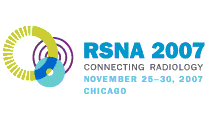
Abstract Archives of the RSNA, 2007
SST15-04
Relationship of the Acromiohumeral Distance Variation and Scapular Diskynesia in Elite Juvenile Tennis Athletes and a Juvenile Non-athlete Population
Scientific Papers
Presented on November 30, 2007
Presented as part of SST15: Musculoskeletal (Shoulder Disorders)
Luiz Guilherme Hartmann MD, Presenter: Nothing to Disclose
Rogerio Augusto Pinto Silva MD, Abstract Co-Author: Nothing to Disclose
Joao Bilo, Abstract Co-Author: Nothing to Disclose
Artur R.C. Fernandes MD, Abstract Co-Author: Nothing to Disclose
First, to compare the acromio-humeral distance (AHD) variation during active abduction measured by ultrasonography in elite juvenile tennis athletes and a juvenile non-athlete population; second, to evaluate the relationship between clinical tests for scapular dyskinesia and AHD variations.
Both shoulder and scapular girdle of 53 elite juvenile tennis athletes and 20 non-athlete juvenile population were evaluated clinically and by ultrasonography. The clinical evaluation consists in tests for detection of scapular diskynesia, and a questionnaire for general informations about dominant side and anthropometric data. The ultrassonographic evaluation includes measurement of the subacromial space with the patient sitting with the arm at 0° and 60° of active abduction. In both groups, the exclusion criteria were the presence of shoulder pain, prior shoulder surgery and any shoulder pain treatment in the last six months.
In the total evaluation of the 146 shoulders, 24 (16,4%) have scapular diskynesia. In the tennis athletes group, 42 (39,6%) have diskynesia, against only 6 (15%) in control group (p=0,005). The AHD, in rest, the tennis athletes group was thinner than the contol ggroup (p=0,001). During 60 degrees of abduction, there is no statistical significant difference between the two groups.
In the tennis athletes group, we compare the subgroups of with or without diskynesia. In all the 106 examinated shoulders, there was a significant reduction of the AHD during 60 degrees of abduction, but in he diskynesia (42 shoulders), these reduction was significantly greater. The athletes with diskynesia presented an ADH average reduction of 19,3 mm (21,4% compared with the rest measure), while the athletes without diskynesia (62 shoulders), the reduction ADH average reduction was 13,8 mm (16,1%).
There is a strong positive relationship between the reduction of AHD narrowing and the presence of scapular diskynesia in both groups.
Scapular diskynesia is associated with shoulder impingement.The variation of the AHD in rest and abduction may be usefull to evaluate scapular diskynesia and to predict the risk of development of SIS.
Hartmann, L,
Silva, R,
Bilo, J,
Fernandes, A,
Relationship of the Acromiohumeral Distance Variation and Scapular Diskynesia in Elite Juvenile Tennis Athletes and a Juvenile Non-athlete Population. Radiological Society of North America 2007 Scientific Assembly and Annual Meeting, November 25 - November 30, 2007 ,Chicago IL.
http://archive.rsna.org/2007/5015313.html

